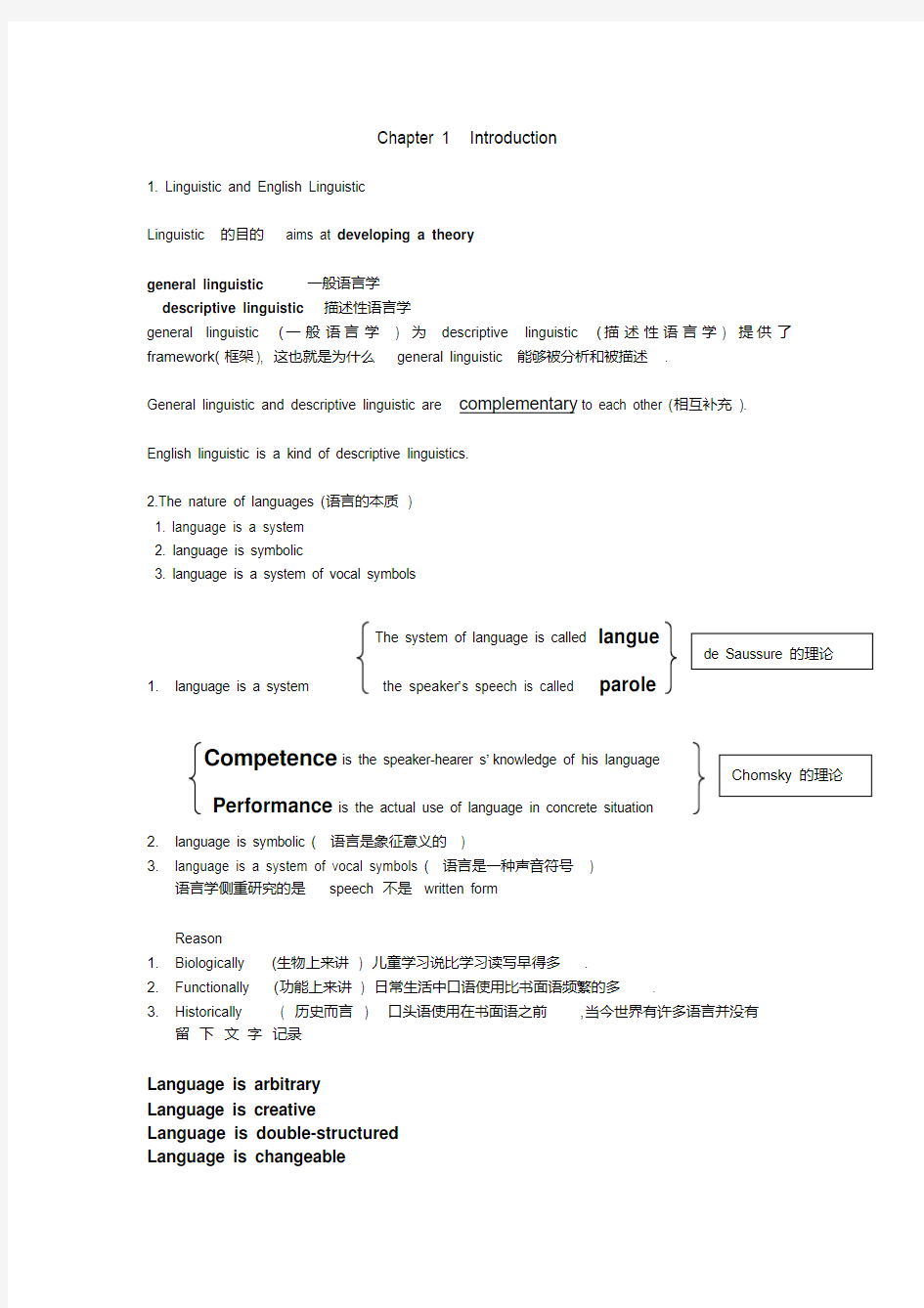

Chapter 1 Introduction
1. Linguistic and English Linguistic Linguistic 的目的aims at developing a theory general linguistic
一般语言学
descriptive linguistic 描述性语言学general linguistic (一般语言学) 为
descriptive linguistic (描述性语言学) 提供了
framework(框架), 这也就是为什么
general linguistic 能够被分析和被描述
.
General linguistic and descriptive linguistic are
complementary to each other (相互补充).
English linguistic is a kind of descriptive linguistics. 2.The nature of languages (语言的本质) 1. language is a system 2. language is symbolic
3. language is a system of vocal symbols
The system of language is called langue
1.
language is a system
the speaker ’s speech is called
parole
Competence is the speaker-hearer ’s knowledge of his language
Performance i s the actual use of language in concrete situation
https://www.doczj.com/doc/1a6632425.html,nguage is symbolic ( 语言是象征意义的)
3.
language is a system of vocal symbols ( 语言是一种声音符号
)
语言学侧重研究的是speech 不是written form
Reason 1.Biologically (生物上来讲) 儿童学习说比学习读写早得多.
2.Functionally (功能上来讲) 日常生活中口语使用比书面语频繁的多
.
3.
Historically
( 历史而言) 口头语使用在书面语之前
,当今世界有许多语言并没有
留下文字记录
Language is arbitrary
Language is creative
Language is double-structured Language is changeable
de Saussure 的理论
Chomsky 的理论
Language is arbitrary
a linguistic symbol is composed of two things speech
sound( form)形式and the idea( meaning) 意义Language is creative
Language is double-structured
grammatically-meaningful and sound-meaningless
语法上的有意义,声音上的无意义.
Language is changeable
What is the nature of human language?
In a short , it is a system of a rbitrary vocal symbols
The unique features like creativity(创造力)
duality of structure (结构的双重性)
changeability(易变性)
3.Scientific method (科学方法)
1. collecting data ( 收集数据)
2.forming a hypothesis (提出假设)
3.testing the hypothesis (验证假设)
4.drawing conclusions (得出结论)
An important principle of the scientific method Objectivity 客观性
Three biases 三种偏见
1.some languages are primitive and some languages are advanced
有的语言是原始的有的语言是先进的.
2.only the standard variety is the pure form of a language
只有标准的语体才是纯正的语言
3.change is not natural for living language and such a change is a sign of
corruption and decay
语言变化是不自然的变化,变化是衰败的现象.
Sources of data 资料的来源
Collecting data 是研究的首要工作. 假如这语言学家不懂那门语言,他可以找一
个informant ( 为语言学调查提供资料的当地人)
Rules construction
语言描述的首要工作是construct rules ( draw conclusion) 得出结论
How does a linguist construct a rule?
书本p15页中
4.The goal of linguistics 语言学的目的
establish a model of a native speaker’s competence建立一种本族语言的模式
literal model 具体模式physical model
model
theoretical model 理论模式conceptual model
Eg. Which types does a m odel of the competence of a native speaker belong to?
---- theoretical model / conceptual model 理论模式
两个特性
explicitness 明确性the rules of the langue the model contains are clearly
defined
某一门语言的规则定义非常明确
generative 生成性use a finite set of rules to generate an infinite number
of sentences
用有限的规则创造无限的句子
四种研究的方向
Phonological 音位知识
Morphological 词法知识
Syntactic 句法知识
Semantic 语义知识
Phonological 音位知识sound and sound patterns of his language
研究语音和语音模式
Morphological 词法知识how a word is formed
如何构词的模式
Syntactic 句法知识whether a sentence is true or not
句子是否符合语法
Semantic 语义知识meaning of a language 语言的意义5.Sub-branch of linguistics 语言学的分支
Phonetics 语音学Study speech sound 研究语音的科学
Phonology 音系学Study sound system 研究语音体系的科学
Phoneme音素
Morphology 形态学Word formation and the internal structure of work 构词法和词的内部结构
Morpheme词素
Syntax 句法How word are combined to form phrases 单词如何构成短语
How phrases are combined by rules to form sentence 短语如何构成句子
PS rules T rules
Semantics 语义学The meaning of words and sentence 单词和短语的意义
6.The father of modern linguistics—Saussure现代语言学之父
(瑞士人come from Swiss)
现代语言学开始于20世纪,但是发展迅速,有两大流派(two schools)
Structure linguistics 结构语言学
Transformational-generative Grammar 转换生成语法
TG-grammar
为什么说Saussure是现代语言学的奠基人呢?
1.’’
A Course in General Linguistics” is the first real essay on linguistic theory
<<普通语言学>>是第一本真正意义上的语言学专著.
2. The distinctions between synchronic and diachronic, syntagmatic and
paradigmatic,langue and parole. Show us a brief explanation of these basic and significant distinctions.
书中关于共时研究和历时研究, 横向关系和纵向关系, langue 和parole的阐述很明了.
4. A few theoretical distinctions introduced have become foundations of linguistic
study and exerted great influence on the latter development of linguistics.
其中的一些理论成为语言学的基础对后来的语言学发展影响很大.
Chapter 2 phonetics 语音学
定义phonetics is known as the science that studies speech sounds of all human language
Three sub-branches 三个分支
articulatory phonetics 发音语音学
acoustic phonetic 声学语言学
auditory phonetic 听觉语言学
发音器官articulators
What is vocal tract?
-- The speech organs above the larynx from the vocal tract 喉以上的器官称之为vocal tract
Consonants and vowels 辅音和元音
Consonant : is a speech sound where the airstream from the lungs is either completely blocked or partially blocked or where the opening is so narrow that the
air escapes with audible friction
气流完全封闭或部分封闭,或开口小并且有摩檫
Vowels :is a speech sound that the airstream from the lungs is not blocked in any way in the mouth or throat, and which is usually pronounced with
vibration of the vocal cords.
气流不受阻碍,发音时声带一定振动。(两者同时具备)
国际音标The International Phonetic Alphabet
为什么要求用国际音标
1.The spelling of words is not a reliable means, a single letter may represent different sounds 一词多音
2.Different letters or combinations of letters may represent a single sound 多音一词
在国际音标中72辅音25元音
描述辅音的四种方法
.........
1.The position f the soft plate(velum)软腭的位置
2.The presence or the absence of vocal-cord vibration 声带是否振动
3.The place of articulation 发音部位
4.The manner of articulation 发音方式根据position of the soft plate 可以分为oral sound
nasal sound
根据presence or absence of vocal-cord vibration 可以分为voiceless sound
清音
voiced sound
浊音根据place of articulation 可以分为
1. bilabials 双唇音
https://www.doczj.com/doc/1a6632425.html,biodentals 唇齿音
3.dentals 舌齿音
4.alveolars 齿龈音
5.post-alveolars 后齿龈音
6.alveo-palatals 齿龈腭音
7.palatals 硬腭音
8.velars 软腭音
9.glottals 声门音
根据Manner of articulation 可以分为
1.stops plosives 破裂音
nasals 鼻音
2.fricatives 摩擦音
3.affricatives 破擦音
4.liquids 流音
5.glides 滑音/音渡也称为semi-vowels ( 半元音)
描述元音的三种方法
.........
1. the state of the velum 软腭的位置
2. the position of the tongue 舌头的位置
3. the shapes of lips 嘴唇的位置
Velum state 根据velum(软腭)是上还是下
Tongue position 前中后front-central-back
上中下high-middle-low
Lip rounding rounded vowels 圆唇元音
unrounded vowels 不圆唇元音
diphthongs 复合元音,双元音
英语中有8个双元音.它们可以分为3组
centering
集中双元音
diphthongs
复合元音,
双元音
closing
合口双元音
triphthongs 三重元音,三合元音
就是合口双元音+
Phonetic features
phonetic features + value = feature specification 语音特征+音值构成了语音特征的说明
8种common features 书本P43页